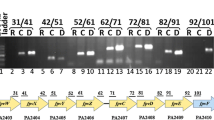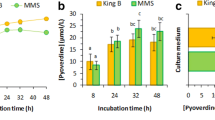Abstract
An experiment was planned to evaluate the behavior of Paenibacillus polymyxa SQR-21 under differential iron availability. P. polymyxa was grown under three differential iron conditions (0, 2, 20 μM). Iron starvation slowed bacterial growth and at all iron levels, pH of liquid culture was decreased, but maximum decrease was observed at highest iron level. Cell surface ferrireductase activity decreased as culture aged, while extracellular Fe3+-reducing activity constantly increased. Hydroxamates type siderophores production was increased with the decrease in iron levels. Numerous cellular proteins were expressed by P. polymyxa in the range of 5–140 kDa and several of them showed conspicuous differential iron regulation. P. polymyxa seems to have more than one type of iron acquisition mechanism including gradual release of organic acids, cell surface ferrireductases, extracellular reductants, and secretion of low molecular weight hydroxamates chelators. This article is the first to report the kinetic study of P. polymyxa under differential iron availability. The information provided here gives initial information about the iron uptake mechanism of P. polymyxa.





Similar content being viewed by others
References
Arnow LE (1937) Colorimetric determination of the components of 3,4-dihydroxyphenylalanine-tyrosine mixtures. J Biol Chem 18:531–537
Bhaduri S, Demchick PH (1983) Simple and rapid method for disruption of bacteria for protein studies. Appl Environ Microbiol 46:941–943
Bradford MM (1976) A rapid and sensitive method for the quantitation of microgram quantities of protein utilizing the principle of protein-dye binding. Anal Biochem 72:248–254
Csaky TZ (1948) On the estimation of bound hydroxylamine in biological materials. Acta Chem Scand 2:450–454
Garner BL, Arceneaux JEL, Byers BR (2004) Temperature control of a 3,4-dihydroxybenzoate (protocatechuate)-based siderophore in Bacillus anthracis. Curr Microbiol 49:89–94
Helbig J (2001) Biological control of Botrytis cinerea Pers. ex Fr. in strawberry by Paenibacillus polymyxa (Isolate 18191). J Phytopathol 149(5):265–273
Homuth M, Peter VW, Rohde M, Gerlach GF (1998) Identification and characterization of a novel extracellular ferric reductase from Mycobacterium paratuberculosis. Infect Immun 66:710–716
Lopez-Goni I, Moriyon I, Neilands JB (1992) Identification of 2,3-dihydroxybenzoic acid as a Brucella abortus siderophore. Infect Immun 60:4496–4503
de Luca NG, Wood PM (2000) Iron uptake by fungi: contrasted mechanisms with internal or external reduction. In: Poople RK (ed) Advances in microbial physiology. Sheffield, UK, pp 39–74
Machuca A, Milagres AMF (2003) Use of CAS-agar plate modified to study the effect of different variables on the siderophore production by Aspergillus. Lett Appl Microbiol 36:177–181
Mahmood M (1970) Trace elements for growth and bulbiformin production by Bacillus subtilis. J Appl Microbiol 35:1–5
Morrissey JA, Williams PH, Cashmore AM (1996) Candida albicans has a cell-associated ferric-reductase activity, which is regulated in response to levels of iron and copper. Microbiology 142:485–492
Neilands JB (1984) Methodology of siderophores. Struct Bond 58:1–24
Nyhus KJ, Wilborn AT, Jacobson ES (1997) Ferric iron reduction by Cryptococcus neoformans. Infect Immun 65:434–438
Renshaw JC, Robson GD, Trinci APJ, Wiebe MG, Livens FR, Collison D, Taylor RJ (2002) Review: fungal siderophores—structures, functions and applications. Mycol Res 106:1123–1142
Sharma PK, Rao KH (2001) Role of a heterotrophic Paenibacillus polymyxa bacteria in the bioflotation of some sulfide minerals, p. 67. In: Kawatra SK, Natarajan KA (eds) Mineral biotechnology. Society for Mining, Metallurgy and Exploration, Littleton
Siegel LS (1981) An International journal effect of iron on growth and toxin production by Clostridium botulinum Type A. Curr Microbiol 6:127–130
Siddiqui ZA, Baghel G, Akhtar MS (2007) Biocontrol of Meloidogyne javanica by rhizobium and plant growth-promoting rhizobacteria on lentil. World J Microbiol Biotechnol 23:435–441
Stookey LL (1970) Ferrozine: a new spectrophotometric reagent for iron. Anal Chem 42:779–781
Temirov YV, Esikova TZ, Kashparov IA, Balashova TA, Vinokurov LM, Alakhov YB (2003) Catechol siderophore, produced by thermo-resistant strain of Bacillus licheniformis VK21. Russ J Bioorg Chem 29:542–549
Timmerman MM, Woods JP (1999) Ferric reduction is a potential iron acquisition mechanism for Histoplasma capsulatum. Infect Immun 67:6403–6408
Vartanian MD (1988) Differences in excretion and efficiency of the aerobactin and enterochelin siderophores in a bovine pathogenic strain of Escherichia coli. Infect Immun 56:413–418
Truper HG (2005) The type species of the genus Paenibacillus Ash et al. 1994 is Paenibacillus polymyxa. Opinion 77 Judicial Commission of the International Committee on Systematics of Prokaryotes Correspondence. Inter J Syst Evol Microbiol 55:513
Zhang S, Raza W, Yang X, Hu J, Huang Q, Xu Y, Liu X, Shen Q (2008) Control of Fusarium wilt disease of cucumber plants with the application of a bioorganic fertilizer. Biol Fertil Soils 14(8):1073–1080
Acknowledgments
This study was financially supported by National Nature Science Foundation of China (40871126) and China Science and Technology Ministry, 973 Program (2007CB109304) and 863 program (2006AAD10Z416), and China Agriculture Ministry (2006-G62). We thank Professor Warren Dick at Ohio State University, USA for his polishing the English of this article.
Author information
Authors and Affiliations
Corresponding author
Rights and permissions
About this article
Cite this article
Raza, W., Shen, Q. Growth, Fe3+ Reductase Activity, and Siderophore Production by Paenibacillus polymyxa SQR-21 Under Differential Iron Conditions. Curr Microbiol 61, 390–395 (2010). https://doi.org/10.1007/s00284-010-9624-3
Received:
Accepted:
Published:
Issue Date:
DOI: https://doi.org/10.1007/s00284-010-9624-3




